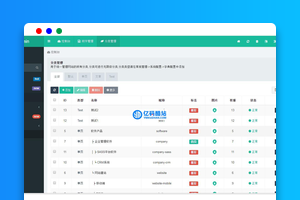【亿码酷站-编程开发教程】收集全网优质教程及源码资源!
全网优质软件开发、平面设计等教程及精品源码资源一站可得,www.ymkuzhan.com!
下面由
golang教程栏目给大家介绍golang之排序使用,希望对需要的朋友有所帮助!

golang标准库实现了许多常用的排序方法,比如对整数序列排序:sort.Ints(),
那么如果对自定义的数据结构排序怎么做呢?
比如对一个用户列表,按他们的积分排序:
首先定义数据结构,为了能清楚说明问题,只给两个字段。
type User struct {
Name string
Score int}type Users []User
golang中想要自定义排序,自己的结构要实现三个方法:
// 摘自: $GOROOT/src/sort/sort.gotype Interface interface {
// Len is the number of elements in the collection.
Len() int
// Less reports whether the element with
// index i should sort before the element with index j.
Less(i, j int) bool
// Swap swaps the elements with indexes i and j.
Swap(i, j int)}
这个设计太妙了有没有,想想我们学过的排序,都要序列长度,比大小,交换元素。
那对上述的Users,也就是用户列表如何使用golang的排序呢?
先按它说的,实现这三个方法:
func (us Users) Len() int {
return len(us)}func (us Users) Less(i, j int) bool {
return us[i].Score < us[j].Score}func (us Users) Swap(i, j int) {
us[i], us[j] = us[j], us[i]}
然后就能排序了:
func main() {
var us Users const N = 6
for i := 0; i < N; i++ {
us = append(us, User{
Name: "user" + strconv.Itoa(i),
Score: rand.Intn(N * N),
})
}
fmt.Printf("%v\n", us)
sort.Sort(us)
fmt.Printf("%v\n", us)}
可能的输出为:
可以看到,分数从小到大排列了。
不过一般我们积分这种东西都是从大到小排序的,只需将sort.Sort(us)改成sort.Sort(sort.Reverse(us))就行。
确实很方便。
当然,如果出于特殊需要,系统提供的排序不能满足我们的需要,
还是可以自己实现排序的, 比如针对上述,自己来排序(从小到大):
func myqsort(us []User, lo, hi int) {
if lo < hi {
pivot := partition(us, lo, hi)
myqsort(us, lo, pivot-1)
myqsort(us, pivot+1, hi)
}}func partition(us []User, lo, hi int) int {
tmp := us[lo]
for lo < hi {
for lo < hi && us[hi].Score >= tmp.Score {
hi--
}
us[lo] = us[hi]
for lo < hi && us[lo].Score <= tmp.Score {
lo++
}
us[hi] = us[lo]
}
us[lo] = tmp return hi}
一个简单的快速排序,调用时只需要myqsort(us)就可以 了。
总结:
- 自定义序列要实现Less, Swap, Len三个方法 才行
欢迎补充指正!
关于golang之排序使用—–文章转载自PHP中文网如有侵权请联系admin#tyuanma.cn删除
关于redis数据库数量配置、切换及指定数据库
转载请注明来源:关于golang之排序使用_亿码酷站_亿码酷站
本文永久链接地址:https://www.ymkuzhan.com/1817.html
本文永久链接地址:https://www.ymkuzhan.com/1817.html
下载声明:
本站资源如无特殊说明默认解压密码为www.ymkuzhan.com建议使用WinRAR解压; 本站资源来源于用户分享、互换、购买以及网络收集等渠道,本站不提供任何技术服务及有偿服务,资源仅提供给大家学习研究请勿作它用。 赞助本站仅为维持服务器日常运行并非购买程序及源码费用因此不提供任何技术支持,如果你喜欢该程序,请购买正版! 版权声明:
下载本站资源学习研究的默认同意本站【版权声明】若本站提供的资源侵犯到你的权益,请提交版权证明文件至邮箱ymkuzhan#126.com(将#替换为@)站长将会在三个工作日内为您删除。 免责声明:
您好,本站所有资源(包括但不限于:源码、素材、工具、字体、图像、模板等)均为用户分享、互换、购买以及网络收集而来,并未取得原始权利人授权,因此禁止一切商用行为,仅可用于个人研究学习使用。请务必于下载后24小时内彻底删除,一切因下载人使用所引起的法律相关责任,包括但不限于:侵权,索赔,法律责任,刑事责任等相关责任,全部由下载人/使用人,全部承担。以上说明,一经发布视为您已全部阅读,理解、同意以上内容,如对以上内容持有异议,请勿下载,谢谢配合!支持正版,人人有责,如不慎对您的合法权益构成侵犯,请联系我们对相应内容进行删除,谢谢!

 成为VIP
成为VIP








